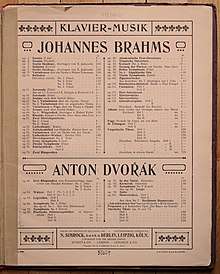N. Simrock
N. Simrock (in German Musikverlag N. Simrock, Simrock Verlag, or simply Simrock) was a German music publisher founded by Nikolaus Simrock which published many 19th-century German classical music composers. It was acquired in 1929 by Anton Benjamin.

The firm was founded in 1793 by Nikolaus Simrock in Bonn. It was expanded by his son Peter Joseph in the 19th century, and in 1870 moved to Berlin by the latter's son Fritz.[1] His nephew Hans Simrock later ran the company, and in 1907 acquired another music publisher, Bartolf Senff of Leipzig.[2][3] In 1911 the company merged with Albert Ahn's publishing house to form Ahn & Simrock, headquartered in Bonn and Berlin, but later separated from it. In 1929 it was sold to the Leipzig publisher Anton J. Benjamin,[2][4][5] which was re-established in 1951 in Hamburg[6] and acquired by Boosey & Hawkes in 2002.[5] Many of the company's archives and plates were lost in the Second World War and had to be reconstructed by reproducing old editions.[7] The remaining archives were mostly held in what is now the Saxon State Archive in Leipzig, but some material was dispersed in the 1990s and early 2000s.[8]
The company was the first publisher of the music of a veritable "Who's Who" of classical music composers, including Wolfgang Amadeus Mozart (what must have been a hand-written copy of The Magic Flute),[9] Joseph Haydn, Ludwig van Beethoven (13 first editions), Robert Schumann (including his Third Symphony), Johannes Brahms,[2][10] Felix Mendelssohn (such as his oratorios Elias and Paulus),[11] Max Bruch (including his Violin Concerto No. 1), Antonín Dvořák[2], Elisabeth Wintzer, and Josef Suk.
Notes
- Donald William Krummel and Stanley Sadie, Music Printing and Publishing, Norton/Grove handbooks in music, New York: Norton, 1990, ISBN 9780393028096, p. 107.
- Otto Biba, "Die Simrocks—Verleger für Beethoven wie für Brahms", in Johannes Brahms und Bonn, ed. Martella Gutiérrez-Denhoff, Bonn: Stadt Bonn, Beethoven-Haus, 1997, ISBN 9783922832164, p. 89 (in German)
- Beiträge zur Geschichte des Buchwesens 3 (1968) p. 204 (in German)
- The School Musician Director and Teacher 56 (1985) p. 42.
- Ludwig Finscher and Friedrich Blume, Die Musik in Geschichte und Gegenwart: allgemeine Enzyklopädie der Musik, Part 2, Volume 15, Kassel: Bärenreiter, 2006, ISBN 9783476410306, p. 837 (in German)
- Krummel and Sadie, p. 170.
- The Instrumentalist 47 (1992) pp. 5, 106.
- Michael Freyhan, The Authentic Magic Flute Libretto: Mozart's Autograph Or the First Full Score Edition?, Lanham, Maryland: Scarecrow, 2009, ISBN 9780810869677, p. 159.
- Freyhan, p. 68, note 51.
- Brahms' letters to Fritz Simrock were published in 1917–19; Peter Schmitz, Johannes Brahms und der Leipziger Musikverlag Breitkopf & Härtel, Abhandlungen zur Musikgeschichte 20, Göttingen: V & R, 2009, ISBN 9783899717280, p. 21 and note 23 (in German)
- "Nikolaus Simrock" (in German). Stadtmuseum Bonn. 2012. Archived from the original on 27 April 2012. Retrieved 1 May 2012.
References
- Eitner, Robert (1892), "Simrock, Nicolaus", Allgemeine Deutsche Biographie (ADB) (in German), 34, Leipzig: Duncker & Humblot, pp. 385–386
- Musikverlag Simrock: Eine Auswahl der besten Werke. Catalogue. Berlin/Leipzig: N. Simrock Verlag, [1913]. OCLC 504414249
- Sieghard Brandenburg. "Die Gründungsjahre des Verlags N. Simrock in Bonn". Bonner Geschichtsblätter 29 (1977) 28–36 (in German)
- N. Simrock: Scores at the International Music Score Library Project (IMSLP)